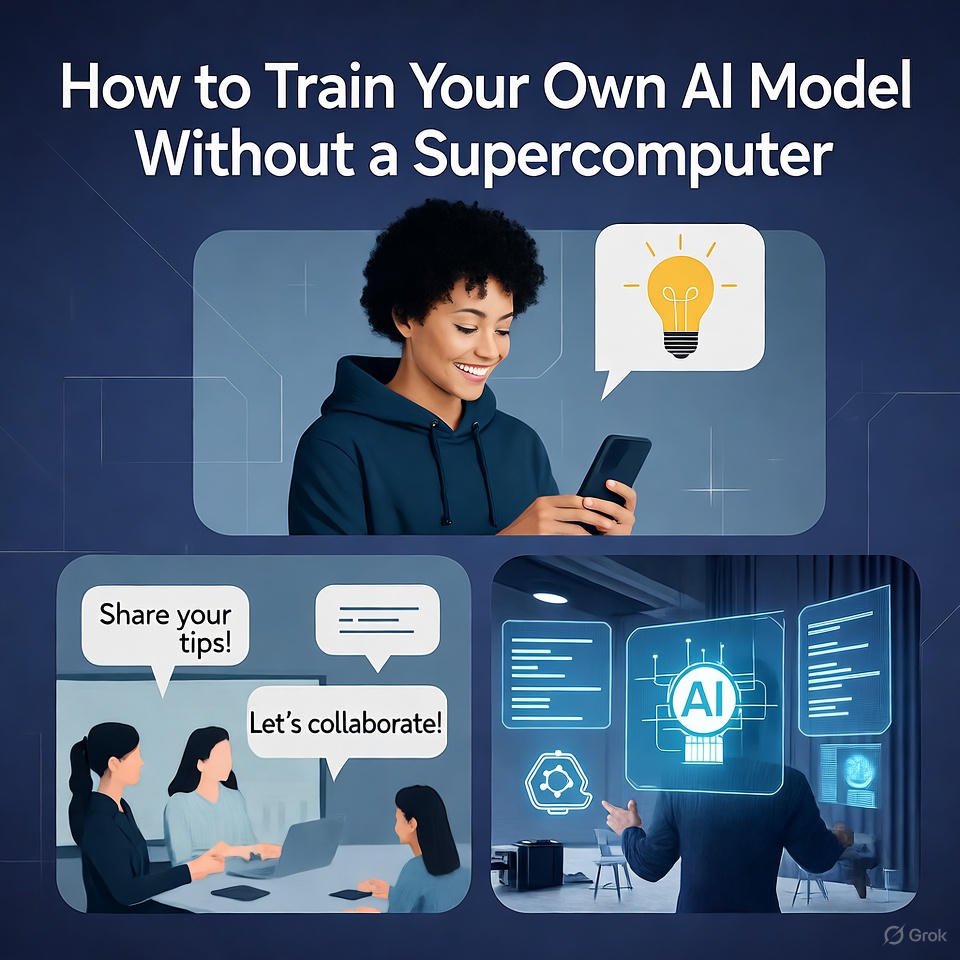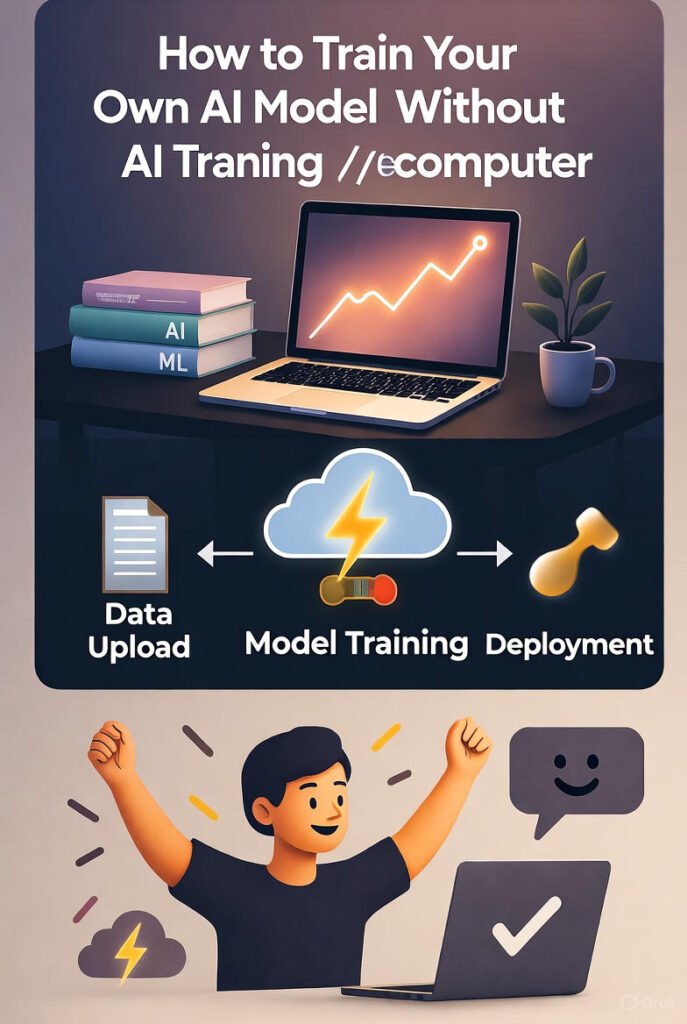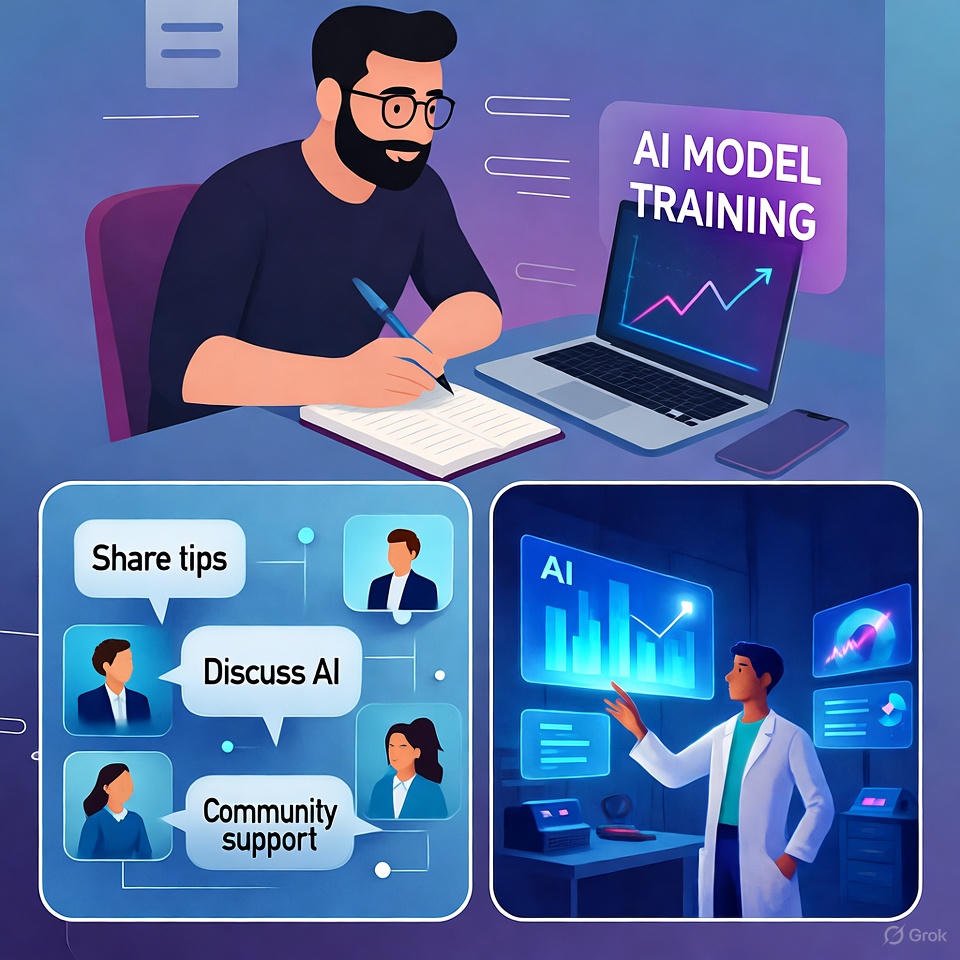
Introduction: You Don’t Need a Supercomputer to Build Smart AI
Not long ago, training an artificial intelligence model seemed like a luxury only giant tech companies could afford. The idea of teaching machines to see, write, or understand required massive datasets, expensive GPUs, and dedicated data centers — things far beyond the reach of individuals or small startups.
But today, the landscape has changed dramatically.
With the rise of open-source frameworks, pre-trained models, and cloud-based training tools, anyone — from students to indie developers — can train their own AI models using modest resources. You don’t need a multimillion-dollar setup; you just need the right approach, efficient tools, and some creativity.
In this post, we’ll walk through how to train your own AI model without a supercomputer — step-by-step — using methods that are practical, affordable, and effective.
You’ll learn:
- How AI training actually works
- The best lightweight tools and techniques for small setups
- How to optimize your data and training process
- Cost-efficient alternatives to expensive hardware
- Tips to achieve professional results on a budget
Let’s dive in.
1. What “Training an AI Model” Actually Means
Before we start optimizing, let’s break down what training an AI model really involves.
When you “train” a model, you’re essentially teaching it to recognize patterns or make predictions by exposing it to examples. The model learns from these examples, identifies relationships in the data, and gradually becomes capable of making accurate predictions on its own.
Imagine teaching a child how to identify animals:
- You show pictures of cats and dogs.
- They guess which is which.
- You correct their mistakes.
- Over time, they improve their accuracy.
That’s the same principle behind AI training — just with mathematical optimization instead of intuition.
However, training doesn’t always mean starting from scratch. There are three main ways to train an AI model, depending on your goals and available resources.
1.1 Full Training (From Scratch)
This involves building and training a model entirely from the ground up using your own dataset.
It’s powerful but resource-intensive — requiring large datasets, high-end GPUs, and long training times.
Unless you’re conducting deep research or building a unique architecture, this approach isn’t necessary for most people.
1.2 Transfer Learning
This is the most practical method for small setups.
You start with a pre-trained model — one that has already learned general features — and then fine-tune it using your own, smaller dataset.
This drastically reduces computation time and gives great results with minimal resources.
1.3 API-Based or Few-Shot Training
You can also “train” a model by using examples through platforms like OpenAI’s fine-tuning, Hugging Face AutoTrain, or Google Vertex AI.
Here, the heavy lifting happens on the provider’s side — you just provide data and configurations.
In short, transfer learning and few-shot fine-tuning are the sweet spots for anyone working without powerful hardware.

2. Choosing the Right Model for Your Task
The next step is to select the right kind of model. This decision can make or break your project, especially when you’re working with limited computational power.
Different AI models are built for different purposes. Here’s how to decide:
| Task Type | Common Use Cases | Suitable Model Types |
|---|---|---|
| Image Recognition | Detecting objects, identifying products | CNNs like MobileNet or EfficientNet |
| Text Processing | Sentiment analysis, spam detection | Transformer models like DistilBERT |
| Speech Recognition | Converting speech to text | Wav2Vec, DeepSpeech |
| Recommendation Systems | Suggesting products or content | Collaborative Filtering, Autoencoders |
| Generative Tasks | Writing, drawing, or coding | GPT-based or Stable Diffusion variants |
If you’re short on computing power, opt for lightweight model architectures. These are smaller versions of popular models designed for efficiency. Examples include:
- DistilBERT instead of BERT (for text)
- MobileNet instead of ResNet (for images)
- TinyLlama instead of Llama 2 (for language generation)
These compact models are surprisingly capable and can be trained effectively on regular laptops or free cloud platforms.
3. Setting Up Your Environment (Without Breaking the Bank)
You don’t need expensive tools or a fancy setup to train AI models. Thanks to the open-source community, there are plenty of free and accessible frameworks available.
3.1 Choose a Framework
Pick a framework that balances simplicity and performance:
- TensorFlow – Great for all-around use and production-ready models.
- PyTorch – Preferred for flexibility and research projects.
- Hugging Face Transformers – Ideal for text-based AI and pre-trained models.
- Scikit-learn – Lightweight and perfect for classic machine learning tasks.
- FastAI – Simplifies training with friendly abstractions.
3.2 Hardware Options
You don’t need a dedicated GPU workstation. Here are affordable options:
- A laptop or desktop with a mid-range NVIDIA GPU (like GTX 1650 or RTX 3060)
- A MacBook with an M1/M2 chip (these chips handle AI tasks efficiently)
- Free cloud platforms like Google Colab, Kaggle, or Paperspace
- Low-cost pay-as-you-go GPU services like RunPod or Vast.ai
Most of these options are either free or cost a few dollars per hour — far cheaper than maintaining a physical server.
4. Data: The Real Secret Behind Great AI Models
Even the most powerful models fail with poor-quality data. Your model’s intelligence depends entirely on the data you feed it.
4.1 Finding Good Data
You can get datasets from several reliable sources:
- Kaggle Datasets (for all types of AI tasks)
- Google Dataset Search
- Hugging Face Datasets
- UCI Machine Learning Repository
If you’re working on a niche domain, consider creating your own dataset — by collecting data manually, using public APIs, or scraping open websites (within ethical and legal limits).
4.2 Preparing and Cleaning Data
Once you have the data, preparation is key. Clean and organized data improves accuracy while reducing training time.
Essential steps include:
- Removing duplicates and irrelevant samples
- Ensuring consistent formatting (text, images, or audio)
- Normalizing and balancing datasets
- Splitting data into training, validation, and test sets
4.3 Make the Most of Small Data
If your dataset is small, you can still get great results through:
- Data augmentation (creating variations from existing samples)
- Transfer learning (using pre-trained models)
- Synthetic data generation (creating artificial samples using AI tools)
Remember, it’s not about the quantity of data, but the quality and diversity.
5. Smart Training Techniques for Limited Hardware
Here’s the heart of this guide — how to train efficiently without high-end machines.
5.1 Use Transfer Learning
Instead of starting from zero, start from a pre-trained model and fine-tune it on your specific data.
This reduces the number of parameters you need to train, saves computation, and accelerates results.
For example:
- Start with a general model like BERT.
- Train it for a few epochs on your domain-specific text data (like financial news or medical reviews).
- You’ll achieve domain accuracy without extensive compute power.
5.2 Parameter-Efficient Fine-Tuning (PEFT)
PEFT is a modern trick used by researchers to fine-tune huge models using a fraction of their parameters.
Techniques like LoRA (Low-Rank Adaptation) or QLoRA allow you to adjust only small parts of the model while keeping the rest frozen.
This means you can fine-tune billion-parameter models on a laptop GPU with only a few gigabytes of memory.
5.3 Use Smaller Batches and Fewer Epochs
When working with limited memory, you can train using smaller batches of data at a time.
You may need to run more iterations, but it keeps memory usage low and prevents crashes.
Similarly, fine-tuning often requires fewer epochs (training rounds) than full training.
5.4 Gradient Accumulation and Mixed Precision
These are optimization techniques that help you simulate large batch sizes and speed up computation by using lower precision arithmetic — without losing accuracy.
5.5 Cloud-Based Training
If your local machine struggles, move training to the cloud.
Platforms like:
- Google Colab (free GPU)
- Kaggle Notebooks
- Paperspace
- AWS EC2 Spot Instances
offer affordable GPU resources that let you train models faster and more efficiently.
Even better, you can pause and resume work — only paying for what you use.
6. Tracking and Evaluating Progress
Training without monitoring is like driving with your eyes closed.
You need to know if your model is improving or overfitting.
6.1 Measure the Right Metrics
Depending on your problem type:
- For classification: track accuracy, precision, recall, and F1-score.
- For regression: use mean squared error or mean absolute error.
- For text: BLEU or ROUGE scores work well.
6.2 Monitor During Training
Tools like TensorBoard, Weights & Biases, or MLflow help visualize learning curves, performance trends, and training stability.
You’ll see exactly when the model stops improving, helping you decide when to stop training.
6.3 Prevent Overfitting
Overfitting happens when your model memorizes training data instead of generalizing from it.
To avoid this:
- Use techniques like early stopping, which halts training once performance plateaus.
- Add dropout (which randomly deactivates neurons to force learning diversity).
- Keep a separate validation dataset to test progress objectively.

7. Saving and Deploying Your Model
Once your model performs well, it’s time to make it usable in real-world applications.
7.1 Save Only What You Need
Save the trained parameters or the entire model for easy loading later. Lightweight saving formats ensure your model remains portable and efficient.
7.2 Optimize for Deployment
If you want to deploy on mobile or web, use model optimization tools that reduce file size and speed up inference.
Techniques like quantization and pruning can shrink the model dramatically without hurting performance.
7.3 Choose Your Deployment Platform
Depending on your goal:
- For web apps: use frameworks like Flask, FastAPI, or Streamlit.
- For mobile apps: use TensorFlow Lite or CoreML.
- For IoT or edge devices: use optimized runtimes like ONNX or NVIDIA TensorRT.
The key is to tailor deployment to your target environment — not all models need cloud servers.
8. Real-World Example: A Small Model, Big Results
To put this into perspective, consider a simple example: building a sentiment analysis AI for customer feedback.
You don’t need to train a massive GPT-like model.
Instead, start with a small pre-trained language model such as DistilBERT. Then fine-tune it on a few thousand customer reviews labeled as positive or negative.
Within an hour of training on a free Google Colab GPU, you could have a model that predicts sentiment with 90%+ accuracy — all without supercomputers or massive budgets.
This same principle applies to other tasks like image recognition, recommendation systems, or even simple chatbots.
The secret lies in leveraging existing intelligence efficiently.
9. Practical Tips for Training Without a Supercomputer
Here are some practical lessons to keep your training efficient, smooth, and affordable:
- Start Small: Begin with a simple model and dataset. It’s easier to debug and iterate.
- Use Pretrained Models: Always reuse existing intelligence before building your own.
- Optimize Early: Use small batch sizes, efficient data formats, and fewer epochs.
- Save Checkpoints Frequently: Prevent data loss from unexpected interruptions.
- Leverage Free Credits: Many platforms offer free GPU hours — take advantage of them.
- Collaborate Online: Use the open-source community — Hugging Face, GitHub, or Kaggle forums — to share and learn.
- Document Everything: Record experiments, results, and parameters for easy reproducibility.
These small habits can make a huge difference in your productivity and learning curve.
10. When You Don’t Need to Train a Model at All
Sometimes, training your own AI model isn’t even necessary.
If your goal is quick results — like generating text, summarizing articles, or classifying images — pre-trained APIs might be all you need.
Platforms such as OpenAI, Cohere, Google Vertex AI, or Hugging Face Inference API provide ready-to-use AI that can be customized through prompts or minimal fine-tuning.
Training your own model makes sense when:
- You require domain-specific accuracy (e.g., legal or medical data)
- You need full control over your data and privacy
- You want to innovate or experiment with unique ideas
- You’re learning how AI works under the hood
Otherwise, API-based solutions can save you time, effort, and costs.
Conclusion: You Don’t Need a Supercomputer — Just Smart Choices
AI is no longer limited to research labs or tech giants. The rise of open-source tools, pre-trained models, and efficient computing has made it accessible to everyone — including you.
By combining transfer learning, lightweight architectures, and cloud-based platforms, you can train and deploy powerful AI models without needing expensive hardware or massive budgets.
So, the next time you think “I can’t train an AI model — I don’t have the resources,” remember:
It’s not about the power of your computer; it’s about the power of your approach.
Start small. Train smart. And soon, you’ll be building intelligent systems that punch far above their computational weight.